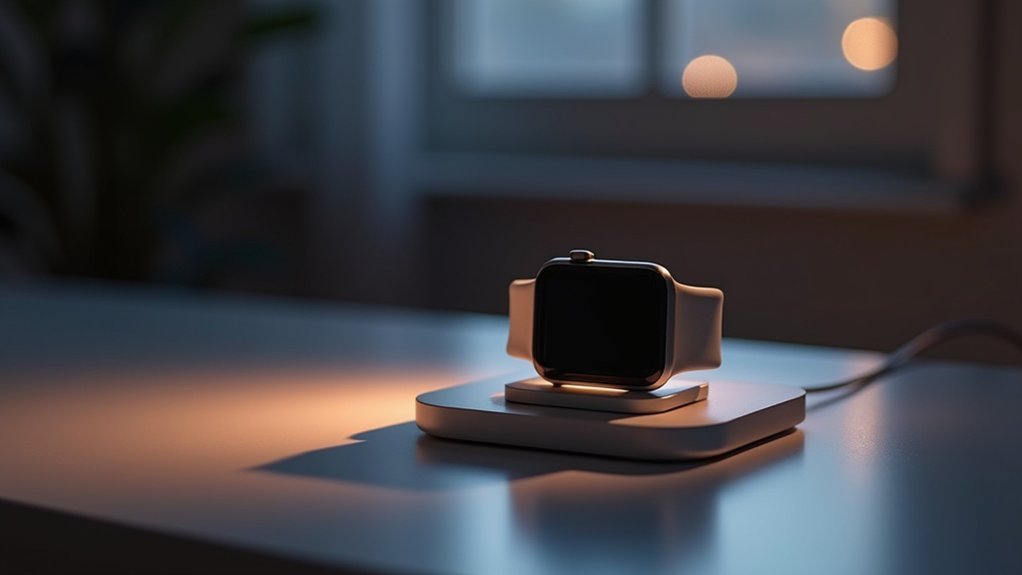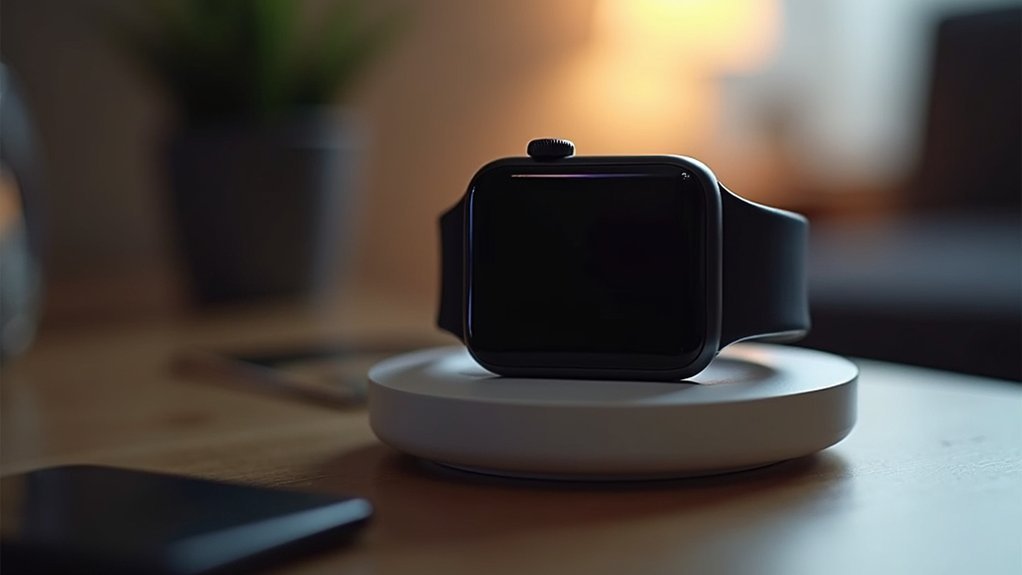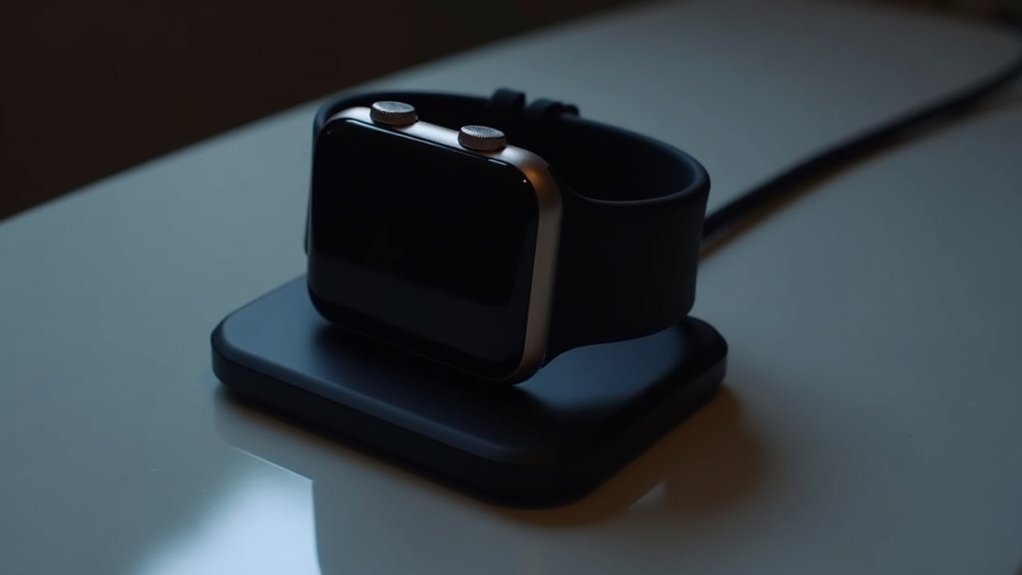Charging your Apple Watch overnight won’t harm the battery, thanks to smart charging technology that prevents overcharging. Modern watchOS features like Optimized Battery Charging limit charging to 80% until you need it fully charged, reducing wear. Your watch actually uses this time to learn your habits and protect battery health. While extended charging generates some heat, the system manages this effectively. Discover how to maximize your Apple Watch battery’s lifespan with proper charging practices.
How Apple Watch Charging Actually Works

When you place your Apple Watch on its charger, a sophisticated magnetic system springs into action. The concave end of the charger snaps magnetically to the back of your watch, automatically aligning it for ideal power transfer.
The magnetic coupling between your Apple Watch and its charger ensures perfect alignment for optimal power delivery with every connection.
You’ll see a charging symbol appear on the screen—yellow if you’re in Low Power Mode.
Your Apple Watch can use several charging options, including the standard Magnetic Charging Cable, the Apple Watch Magnetic Charging Dock, or even Fast Charging with a USB-C Magnetic Fast Charging Cable.
Third-party chargers from companies like Belkin also work, but standard Qi wireless chargers won’t.
For the best charging experience, keep the charging area clean and free of debris. This guarantees a solid connection and efficient power transfer every time. The watch uses machine learning to optimize battery charging by learning your daily routines and delaying charge completion past 80% to reduce battery aging.
The Science Behind Lithium-Ion Batteries
Your Apple Watch’s lithium-ion battery undergoes predictable degradation patterns with each charging cycle, regardless of how carefully you treat it.
Consistently exposing the battery to high temperatures during charging accelerates capacity loss more than extended charging durations at moderate temperatures.
Smart charging algorithms help manage this tradeoff, prioritizing cooler operating conditions while still delivering the power you need for daily use. Research shows that charging current levels significantly impact battery lifespan, with currents above 1C causing accelerated degradation compared to the recommended 0.2C to 0.5C range.
Lithium-Ion Battery Lifecycle
At the heart of every Apple Watch lies a sophisticated lithium-ion battery, engineered to deliver reliable power in a compact form.
These batteries typically last 5-10 years before significant degradation occurs, offering roughly 300-500 charge cycles during their lifetime.
Your charging habits directly impact this lifecycle. Each time you reduce peak charging voltage by 0.10V, you can potentially double the battery’s cycle life. Keeping your watch at moderate temperatures is crucial since elevated temperatures accelerate capacity loss in lithium-ion batteries.
Avoiding deep discharges below 20% and not keeping your watch at full charge for extended periods will help preserve its longevity.
When Apple Watch batteries eventually lose their efficiency, they can still serve second-life purposes, often retaining 70% of their original capacity.
Unfortunately, only about 5% of lithium-ion batteries currently get recycled due to disassembly challenges.
Heat vs. Duration Impact
Though many Apple Watch owners worry about leaving their device charging overnight, understanding the science of heat generation versus charging duration reveals the true concerns.
Heat is the primary battery degradation factor, not simply charging time. Your watch’s battery generates heat through internal resistance during charging, with fast charging protocols considerably intensifying this effect. Modern batteries employ Battery Management Systems that continuously monitor temperature to prevent overheating during extended charging sessions.
When battery temperature exceeds critical thresholds (around 130°C), thermal runaway becomes possible as separators break down and cause internal shorts.
While extended charging does contribute to electrolyte decomposition and parasitic reactions, modern devices mitigate this through trickle-charging.
The real danger comes from combining prolonged charging with high temperatures. For battery longevity, prioritize controlling heat by using slower charging rates and maintaining ideal ambient temperatures rather than obsessing over disconnecting immediately after reaching 100%.
Nightstand Mode: Designed for Overnight Charging

When properly configured, Nightstand Mode transforms your Apple Watch into a convenient bedside clock while it charges overnight. To activate it, navigate to the Apple Watch app on your iPhone, select General > Nightstand Mode, and toggle it on.
Nightstand Mode elegantly converts your charging Apple Watch into the perfect bedside timepiece with just a few simple settings.
For peak performance, position your watch vertically on the charger. The display will show charging status, time, date, and upcoming alarms in an eye-friendly green glow. After a minute, the screen dims to conserve power.
You can check the time with a gentle tap or nudge. When your alarm goes off, press the side button to turn it off or the Digital Crown to snooze the alarm. If the mode doesn’t activate, try repositioning your watch vertically or restarting both devices.
This feature clearly demonstrates Apple’s intention for overnight charging.
Smart Charging Technology and Overcharge Protection
Apple’s smart charging technology provides built-in protection to safeguard your watch’s battery during overnight charging. The system uses machine learning to analyze your daily routines and adjust charging patterns accordingly.
Features like Optimized Battery Charging and Optimized Charge Limit work by preventing your watch from staying at 100% for extended periods, which can wear down lithium-ion batteries over time. Instead, your watch charges to an ideal level based on your usage patterns.
These features are enabled by default, but you can override them by selecting “Charge to Full Now” when needed. However, frequently bypassing these protections may reduce your battery’s lifespan. The Apple Watch’s on-device machine learning predicts when you’ll need a full charge and when you’re likely to leave it connected for extended periods.
The technology balances convenience with battery health, ensuring your Apple Watch charges efficiently while preserving long-term battery performance.
Battery Health Management in Watchos

WatchOS includes sophisticated battery health management features that monitor and adjust your charge cycles to maximize long-term battery life.
You’ll benefit from optimized charging algorithms that learn your daily routine and delay charging past 80% until you need it, effectively minimizing battery stress.
Your watch also actively regulates its temperature during charging to prevent heat-related damage, automatically slowing or pausing charging when conditions might harm the battery.
This feature, available in watchOS 7 and later, uses lithium-ion technology that charges faster and lasts longer than older battery technologies.
Battery Health Management in Watchos
Battery Health Management in watchOS represents one of the most significant features for extending your Apple Watch’s lifespan.
This intelligent system learns your daily charging habits and adjusts power management accordingly to prevent battery degradation. To check your battery’s current health capacity, navigate to Settings app, tap Battery, and select Battery Health for a detailed view of capacity percentage remaining.
You can maximize these features by taking advantage of several built-in tools:
- Optimized Battery Charging: Available since watchOS 7, this feature limits charging to 80% until you need a full charge based on your routine.
- Low Power Mode: Extends battery life by temporarily disabling power-hungry features like Always On Display and background heart monitoring.
- Battery Health Checks: Monitor your battery’s condition directly through the Settings app on your watch.
- Background App Refresh Control: Limit which apps can refresh in the background to conserve power, though apps with complications will still update.
Charge Cycle Optimization
While regular charging habits markedly impact your Apple Watch’s longevity, charge cycle optimization takes battery management to the next level. Available on Apple Watch Series 6 and later with watchOS 10, this feature intelligently manages charging to reduce battery wear. This advanced system utilizes on-device learning to predict when you’ll need a full charge.
| Feature | Benefit |
|---|---|
| Optimized Battery Charging | Stops at 80%, completes just before you need it |
| Pattern Learning | Adapts to your daily usage habits |
| Partial Charging | Varies charge levels based on predicted needs |
| Manual Override | Lets you force a full charge when necessary |
Your watch initially charges to 100% until it learns your patterns. When optimization is active, you’ll notice an open charge ring. You can disable this feature in Settings > Battery > Battery Health, though doing so may reduce your battery’s overall lifespan.
Temperature Control Features
Your Apple Watch incorporates sophisticated temperature control features that safeguard battery health around the clock.
WatchOS uses intelligent algorithms to monitor and regulate temperature during charging sessions, preventing potential heat damage that can greatly reduce battery lifespan.
The system includes several protective measures:
- Battery Management Algorithms adapt charging based on your personal usage patterns, minimizing heat generation.
- Optimized Battery Charging slows down the charging process when your watch is plugged in for extended periods.
- Smart Charging Profile automatically adjusts based on your daily routines and environmental conditions.
- Battery Health Monitoring continuously tracks capacity and thermal conditions, alerting you when issues arise.
These features work seamlessly in the background, allowing you to charge overnight without concerns about temperature-related battery degradation. Charging may temporarily pause if your watch encounters extreme temperatures until normal temperature range is restored.
Heat Generation vs. Charging Duration: What Really Matters
Many Apple Watch users worry excessively about overnight charging, but heat generation—not charging duration—is what truly affects battery health.
Modern Apple Watch chargers are specifically designed with safety features that manage temperature effectively during extended charging sessions. Your watch can remain connected to its charger indefinitely without damaging the battery.
The enhanced battery charging feature further protects your device by controlling charging patterns and limiting time spent at full capacity. This smart functionality helps prevent unnecessary heat buildup.
Environmental factors like room temperature can influence charging speed and heat generation. For ideal battery maintenance, simply verify your watch isn’t exposed to extreme temperatures while charging. The Apple Watch Ultra 2 reaches 80% charge in approximately 1 hour, making overnight charging unnecessary for most users.
Rest assured that Apple’s charging technology incorporates multiple safeguards to protect your device, regardless of how long it stays on the charger.
Real-World Battery Longevity From Nightly Chargers
You’ll find that Apple Watch batteries maintain consistent performance even with nightly charging, as confirmed by long-term user experiences.
The watch’s battery management system intelligently prevents overcharging, allowing you to establish a convenient overnight routine without worrying about premature battery degradation. When left on the charger overnight, the watch stops charging automatically when it reaches full capacity, protecting the battery from stress.
Users consistently report their watches retain satisfactory battery capacity through months and years of nightly charging, contradicting outdated concerns about leaving devices plugged in too long.
Long-Term User Experiences
While concerns about nightly charging have persisted among Apple Watch owners, real-world experiences paint a more reassuring picture. Most users who regularly charge overnight report minimal negative impact on their watch’s battery health over extended periods, especially when using the enhanced charging feature.
The watch’s adaptive charging technology learns your habits and delays reaching 100% until you need it, considerably reducing battery wear from extended periods at full charge. This intelligence makes nightly charging a practical option for most users. The Optimized Battery Charging feature is enabled by default and specifically designed to prolong your battery’s overall lifespan.
- Users with consistent schedules benefit most as the watch learns ideal charging patterns
- Different models (standard vs. Ultra) handle nightly charging similarly despite battery capacity differences
- Fast charging in newer models complements enhanced charging without additional battery strain
- Long-term users report better battery health retention with enhanced charging enabled
Nightly Charging Results
Real-world users who’ve charged their Apple Watch overnight for extended periods report encouraging battery longevity results.
Many maintain good battery health even after years of nightly charging, contradicting worries about battery degradation.
The watch’s intelligent battery management system prevents overcharging by switching to trickle charging once full.
This means your watch only draws the minimal power needed to maintain 100%, rather than constantly charging at full speed.
Apple’s Optimized Charging feature further enhances battery protection by learning your routine and adjusting the charging process accordingly.
Most users find their watches still hold 80-85% of original capacity after two years of nightly charging—well within normal battery aging parameters.
For best results, enable Optimized Charging and avoid frequent complete discharges. Regular overnight charging can actually improve battery longevity through consistent charge cycles rather than letting batteries fully deplete.
Optimized Charging: Apple’s Battery-Saving Feature
Since introducing watchOS 7, Apple has implemented a sophisticated battery management system called Optimized Charging that intelligently preserves your Apple Watch’s long-term battery health.
Apple’s Optimized Charging feature intelligently extends your Apple Watch battery lifespan by adapting to your charging habits.
This feature works by analyzing your charging habits and limiting the time your watch spends at 100% capacity, which greatly reduces battery wear. The system aims to extend battery lifespan by setting optimized charge limits between 80-85% based on your usage patterns.
- Requires watchOS 10+ and works on Apple Watch SE, Series 6+, and Ultra models
- Automatically learns your routine and adjusts charging limits between 80-100% based on when you typically need your watch
- Shows an open ring indicator while actively managing your charge (instead of a closed ring)
- Can be temporarily overridden by tapping “Charge to Full Now” when you need maximum battery immediately
Official Apple Guidance on Watch Charging
Beyond optimizing your charging cycles, understanding Apple’s official guidance helps you get the most from your watch’s battery.
Apple recommends using their magnetic charging cables or dock with at least a 5W power adapter.
There’s no indication from Apple that charging overnight harms your watch. In fact, the device is designed to learn from your charging habits and manage power accordingly.
The watch automatically enters Nightstand mode when charging horizontally, displaying battery percentage. When in Nightstand mode, you can tap the charging button to check battery status.
For safe charging, guarantee you’re using a well-ventilated area and certified power adapters.
If you encounter issues, restart your watch by holding the side button and Digital Crown simultaneously for 10 seconds, or check your charging cable for damage.
Use the Battery section in Settings to monitor charge levels and power consumption patterns.
Third-Party vs. Original Chargers: Safety Considerations
When choosing a charger for your Apple Watch, the decision between original Apple chargers and third-party alternatives involves important safety considerations.
Apple’s chargers are designed specifically for your device, ensuring ideal charging performance and reducing potential risks to your watch’s battery.
Proprietary Apple chargers optimize performance while safeguarding your watch’s battery from potential charging hazards.
- Original Apple chargers use high-quality components that minimize fire hazards and battery damage.
- Third-party chargers must be MFi certified to meet Apple’s safety standards.
- Counterfeit or cheap uncertified chargers often use subpar materials that can overheat.
- MFi certification (“Made for Apple Watch”) indicates the charger has passed Apple’s rigorous safety testing.
Apple conducts over 239 rigorous tests on their charging products to ensure maximum safety and reliability for consumers.
While third-party options can be more affordable, choosing MFi-certified chargers from reputable brands offers the best balance of safety and value when you don’t want to purchase Apple’s more expensive original chargers.
Best Practices for Maximizing Battery Lifespan
While your Apple Watch is designed for daily use, adopting proper battery maintenance habits can greatly extend its overall lifespan.
Try keeping your battery level between 20% and 80% whenever possible, and store your watch at around 50% charge during extended periods of non-use.
Enable optimized battery charging in your settings to reduce battery wear, as this feature delays full charging until just before you typically use your watch.
It’s also wise to avoid extreme temperatures while charging.
For day-to-day use, consider disabling power-hungry features like Always On Display and background app refresh when battery preservation is important. You can manually activate Low Power Mode from the Control Center to significantly extend battery life during critical times.
And remember to use authentic Apple chargers or high-quality third-party options to guarantee safe, efficient charging and prevent potential damage to your battery.
Warning Signs of Battery Degradation
Even with ideal charging habits, your Apple Watch battery will eventually show signs of degradation. Monitoring these indicators can help you determine when it’s time for battery service or replacement.
- Reduced capacity: If your battery health percentage drops below 80% or you notice consistently shorter runtime despite normal usage, your battery is degrading.
- Rapid battery drain: Experiencing 20-30% overnight drops during sleep tracking or needing midday charges despite minimal use signals deterioration. Users have reported sudden battery percentage drops during normal daily activities, even when Battery Health readings appear stable.
- Performance issues: Slow app launches, missing heart rate data during workouts, or reduced wireless performance during low battery states indicate power delivery problems.
- Charging irregularities: Watch unable to reach 100%, requiring frequent recalibration, or displaying “Service Recommended” alerts are clear signs your battery needs attention.
When to Consider Battery Replacement
The decision to replace your Apple Watch battery should be based on several key factors rather than just age alone.
Check your battery’s current capacity under Settings > Battery – replacement is typically warranted when capacity falls below 80%, which usually occurs after approximately 500 full charge cycles.
If your device is over three years old, upgrading to a newer model might be more cost-effective than battery replacement.
AppleCare+ customers should utilize their coverage, which includes battery service when capacity drops below 80%.
Always opt for official Apple replacement to maintain water resistance and avoid compromising functionality.
Remember that chemical aging accelerates in high temperatures and when stored at full charge for long periods.
Consider Apple’s trade-in programs if your battery is severely degraded, as they may offer better value.
Watch for warning signs like unexpected shutdowns, quick battery drainage, and device overheating during normal use, as these are clear indicators that your battery needs replacement.
Frequently Asked Questions
Will Airplane Mode Extend Battery Life During Overnight Charging?
Airplane mode won’t affect your battery during overnight charging. While it saves power during normal use, once your watch is plugged in, it doesn’t impact the charging process or extend your battery’s lifespan.
Can I Charge My Apple Watch Wirelessly With My Phone?
No, you can’t charge your Apple Watch wirelessly with your phone. Apple Watch requires a specific magnetic charger designed for it, not standard Qi wireless charging that phones use. You’ll need the proper Apple Watch charger.
Does Wearing the Watch While Charging Affect Battery Health?
Wearing your Apple Watch while charging won’t negatively impact battery health. The device is designed to handle this, though you might notice slightly slower charging due to your body heat affecting thermal dissipation.
How Does Swimming or Water Exposure Impact Charging Capability?
Water exposure can disrupt charging if moisture enters ports. Don’t charge your watch when wet – it risks corrosion and damage. Always dry thoroughly after swimming and use the water ejection feature before charging.
Will Using Apple Watch in Extreme Climates Require Different Charging Habits?
Yes, extreme climates require adjusted charging habits. You’ll need to warm your watch before charging in cold conditions, avoid charging in hot environments, and limit outdoor battery use during temperature extremes.
In Summary
Charging your Apple Watch overnight won’t harm it—the device’s smart charging technology prevents overcharging. You’ll benefit from Nightstand mode while also having a fully charged watch each morning. Stick with Apple-certified chargers and keep watchOS updated to maintain ideal battery health. When you notice markedly shorter battery life or other persistent issues, it’s probably time to contemplate a battery replacement.





Leave a Reply